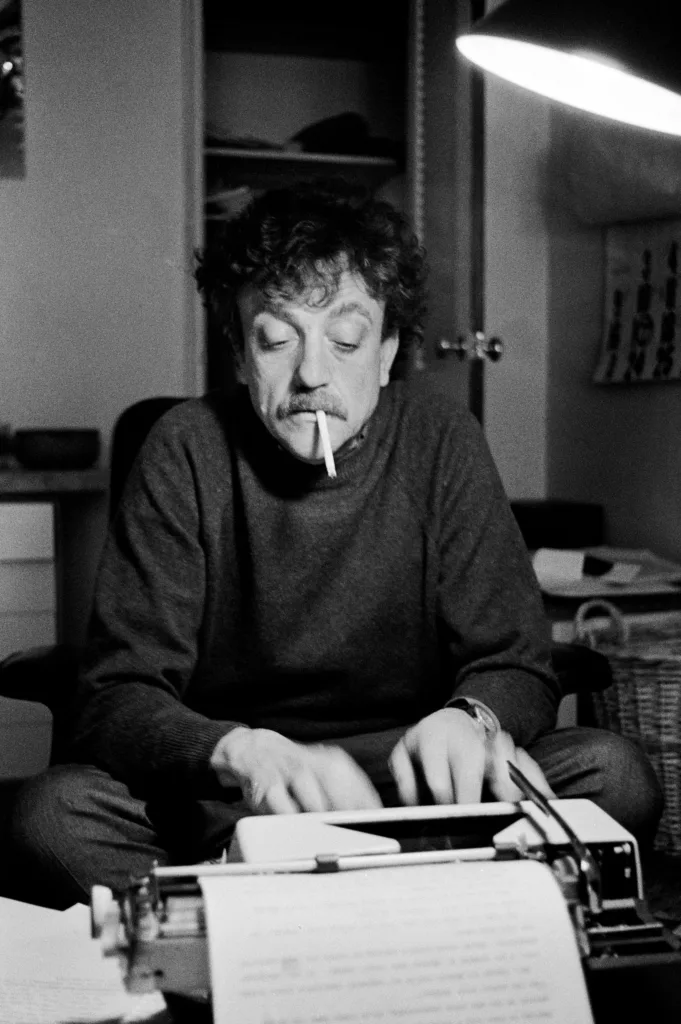In Kurt Vonnegut’s thought-provoking short story, “Harrison Bergeron,” he paints a dystopian world wherein equality is taken to extreme measures. Through the use of various literary devices, Vonnegut explores multiple themes that serve as cautionary reminders about the dangers of excessive government control and the suppression of individuality. In this article, we will delve into the themes of equality vs. individualism, media and ideology, dissent vs. authority, and the power of the arts in “Harrison Bergeron.”
One of the central themes in “Harrison Bergeron” is the conflict between equality and individualism. In this dystopian society, the government enforces strict rules and regulations to ensure everyone is equal. However, this pursuit of equality comes at the cost of individual freedom and personal growth. Through the character of Harrison Bergeron, Vonnegut showcases the potential of exceptional individuals being held back by the constraints of enforced equality.
Another prominent theme in the story is the influence of media and ideology in shaping societal norms. The government-controlled media plays a crucial role in disseminating propaganda and maintaining the status quo. Vonnegut highlights the dangers of a society where the media is used as a tool to manipulate public opinion and perpetuate the ideology of equality. This theme serves as a warning about the potential dangers of media control and its impact on shaping societal values.
Vonnegut explores the theme of dissent vs. authority by highlighting the consequences of challenging the established norms. In this dystopian society, those who resist or question the government’s ideology face severe punishment. The character of Harrison, with his extraordinary abilities, becomes a symbol of rebellion against the oppressive regime. Through his character, Vonnegut emphasizes the importance of questioning authority and the potential consequences of doing so.
Vonnegut underscores the theme of the power of the arts as a means of self-expression and liberation. Despite the government’s attempts to suppress individual creativity and talent, Harrison’s act of rebellion through dance and music symbolizes the transformative power of the arts. This theme serves as a reminder of the inherent human need for self-expression and the potential for art to challenge societal norms and inspire change.
In “Harrison Bergeron,” Kurt Vonnegut masterfully weaves together multiple themes that serve as cautionary reminders about the dangers of excessive government control, the suppression of individuality, and the power of the arts. By exploring themes such as equality vs. individualism, media and ideology, dissent vs. authority, and the power of the arts, Vonnegut prompts readers to reflect on the importance of maintaining a balance between equality and individual freedom. As we navigate the complexities of our own society, it is crucial to remain vigilant and ensure that our pursuit of equality does not come at the expense of personal growth and societal progress.
What Are Two Themes Of Harrison Bergeron?
Two themes of “Harrison Bergeron” are equality and government control.
1. Equality: This theme is central to the story as it explores the concept of forced equality in a dystopian society. In this world, all individuals are handicapped to ensure that no one is more talented, intelligent, or beautiful than others. This extreme form of equality is depicted as oppressive and stifling, as it denies individuals the opportunity to fully express their unique abilities and potential. The story raises questions about the true meaning of equality and the dangers of absolute equality without regard for individual differences.
2. Government Control: Another prominent theme in “Harrison Bergeron” is the idea of government control. The story portrays a totalitarian government that enforces its vision of equality through strict regulations and handicaps. The government’s aim is to maintain control over every aspect of people’s lives, suppressing any form of individuality or excellence. This theme serves as a critique of authoritarian regimes and explores the dangers of unchecked government power. It highlights the potential loss of personal freedom and the suppression of human potential under such systems.
“Harrison Bergeron” explores the themes of equality and government control to shed light on the consequences of extreme attempts to enforce equality and the dangers of oppressive governments.

Which Is The Best Theme Statement For Harrison Bergeron?
The best theme statement for Kurt Vonnegut’s story “Harrison Bergeron” is that equality, while seemingly desirable, can actually hinder both individual and societal success. This theme serves as a warning about the dangers of striving for absolute equality.
In the story, the government enforces extreme measures to ensure equality among its citizens. Individuals with exceptional abilities or attributes are handicapped through the use of technological devices, leveling the playing field for all. However, this forced equality leads to a society where mediocrity is celebrated and ambition is suppressed.
The theme statement highlights the negative consequences of this enforced equality. It suggests that by limiting individuals’ potential and suppressing their unique qualities, society as a whole suffers. Success, innovation, and progress are stifled when everyone is forced to be the same, leading to a stagnant and unfulfilled society.
Furthermore, the theme statement emphasizes the irony in this pursuit of equality. While the intention may be to create a fair and just society, the end result is an unequal distribution of abilities and opportunities. The handicaps imposed on individuals are not equal, as some are burdened more heavily than others. This inequality is not only unjust but also counterproductive to the goal of achieving true equality.
To summarize, the theme statement for “Harrison Bergeron” is that striving for absolute equality can hinder both individual and societal success. This warning highlights the negative consequences of suppressing individuality and uniqueness, ultimately leading to an unequal and unfulfilled society.
What Are Some Themes In Harrison Bergeron?
Some of the prominent themes in the short story “Harrison Bergeron” by Kurt Vonnegut include equality vs. individualism, media and ideology, dissent vs. authority, and the power of the arts.
1. Equality vs. Individualism: The story explores the conflict between the desire for equality and the importance of individualism. In the dystopian society depicted in the story, everyone is forced to be equal through the use of handicaps. This extreme pursuit of equality results in the suppression of individual talents, abilities, and differences.
2. Media and Ideology: The story highlights the influence of media and ideology in shaping public opinion and controlling society. The government uses various forms of media, such as television broadcasts, to promote the ideology of equality and maintain control over the population. The media is shown as a powerful tool for spreading propaganda and shaping people’s thoughts and beliefs.
3. Dissent vs. Authority: The theme of dissent vs. authority is also explored in “Harrison Bergeron.” The government in the story exercises strict control over its citizens, suppressing any form of dissent or rebellion. Harrison, the main character, challenges this authority by breaking free from his handicaps and attempting to overthrow the government’s oppressive regime. This theme raises questions about the balance between individual rights and the authority of the state.
4. The Power of the Arts: Another theme in the story is the power of the arts to challenge and transcend societal norms. Harrison’s dance and rebellion against the handicaps symbolize the power of artistic expression to disrupt the status quo and inspire others to question the established order. The story suggests that art can be a catalyst for change and a means of breaking free from oppressive systems.
“Harrison Bergeron” explores themes of equality vs. individualism, media and ideology, dissent vs. authority, and the power of the arts. These themes provoke thought and discussion about the role of government, the importance of individuality, and the potential of art to challenge societal norms.
What Is The Lesson Behind Harrison Bergeron?
The lesson behind “Harrison Bergeron” is that society should value and embrace individual differences instead of suppressing them. The story, written by Kurt Vonnegut, is set in a future dystopian society where everyone is equal in every aspect. This equality is enforced through the use of handicaps, which are devices that limit individuals’ abilities and intelligence to ensure that no one stands out or excels.
The main character, Harrison Bergeron, is exceptionally intelligent, strong, and attractive. However, he is burdened with numerous handicaps to bring him down to the same level as everyone else. Despite these challenges, Harrison rebels against the oppressive system and strives for freedom and individuality.
The story teaches us that suppressing individual talents, skills, and differences ultimately leads to a bland and stagnant society. By forcing everyone to be the same, the society in “Harrison Bergeron” eliminates the possibility of progress, creativity, and personal growth. It highlights the importance of embracing diversity and allowing people to express their unique abilities and characteristics.
The lesson of the story can be summarized as follows:
1. Suppression of individual differences leads to a stagnant society.
2. Diversity and individuality are essential for progress and personal growth.
3. Handicapping or suppressing people’s abilities hinders their potential and limits their contributions.
4. Celebrating and embracing differences can lead to a more vibrant and dynamic society.
“Harrison Bergeron” teaches us the lesson that society should embrace and celebrate individual differences rather than suppressing them. It emphasizes the importance of diversity, personal growth, and the power of unique talents and abilities to drive progress and innovation.

Conclusion
Kurt Vonnegut’s “Harrison Bergeron” serves as a thought-provoking and cautionary tale about the dangers of enforced equality. Through the use of themes such as equality vs. individualism, media and ideology, dissent vs. authority, and the power of the arts, Vonnegut effectively delivers his message to readers.
One of the main themes explored in the story is the conflict between equality and individualism. Vonnegut depicts a dystopian society where everyone is forced to be equal, regardless of their natural abilities or talents. This extreme form of equality ultimately stifles individual potential and prevents individuals from reaching their fullest potential. The story highlights the importance of embracing and celebrating differences rather than suppressing them.
Furthermore, Vonnegut addresses the role of media and ideology in shaping societal norms. In the story, the government controls the media to manipulate public opinion and maintain its control over the masses. This theme serves as a warning about the dangers of a society where the media is used as a tool for propaganda and the suppression of dissenting voices.
The theme of dissent vs. authority is also prominent in “Harrison Bergeron.” The story depicts a society where any form of dissent or rebellion is swiftly and violently suppressed. This theme serves as a reminder of the importance of preserving individual freedoms and the right to challenge oppressive systems.
Lastly, Vonnegut emphasizes the power of the arts in challenging societal norms and inspiring change. The character of Harrison Bergeron embodies the potential for artistic expression to disrupt the status quo and push boundaries. This theme serves as a reminder of the transformative power of art and its ability to provoke thought and inspire action.
“Harrison Bergeron” serves as a powerful critique of a society obsessed with enforced equality. Vonnegut’s use of various themes, such as equality vs. individualism, media and ideology, dissent vs. authority, and the power of the arts, enhances the message of the story and leaves readers contemplating the delicate balance between equality and individual freedom.
